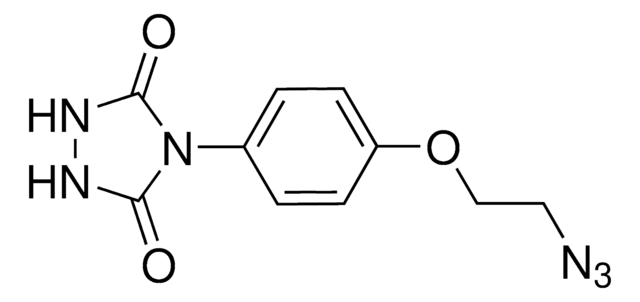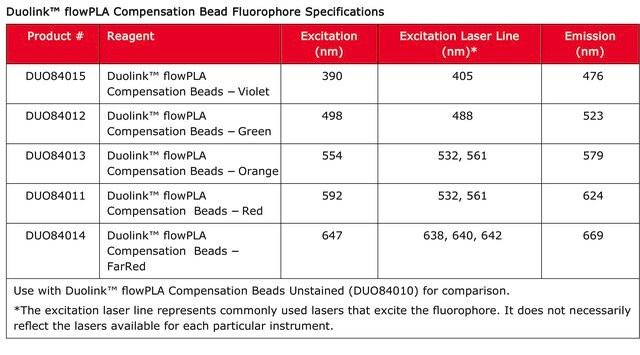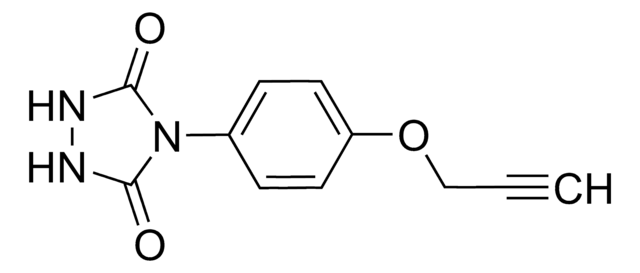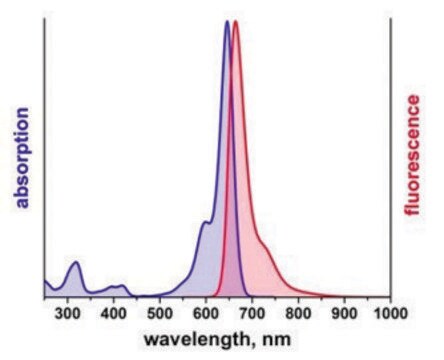DUO84011
Duolink® flowPLA Compensation Beads - Red
For flow cytometry standard and multiplex analysis
Faça loginpara ver os preços organizacionais e de contrato
About This Item
Código UNSPSC:
23201100
NACRES:
NA.32
Produtos recomendados
Nível de qualidade
linha de produto
Duolink®
Formulário
slurry
técnica(s)
flow cytometry: suitable
immunocytochemistry: suitable
immunofluorescence: suitable
multiplexing: suitable
proximity ligation assay: suitable
fluorescência
λex 592 nm; λem 624 nm (excitation laser line 532, 561 nm)
adequação
suitable for fluorescence
Condições de expedição
wet ice
temperatura de armazenamento
2-8°C
Aplicação
Duolink® proximity ligation assay(PLA®) allows for endogenous detection of protein interactions, post translational modifications, and protein expression levels at the single molecule level in fixed cells and tissue samples.
It is recommended that Duolink® compensation beads should be used when performing a multiplexed experiment (DUO96001) to save on time and reagent cost, rather than using precious sample. This product can be used to determine flow cytometry instrumentation collection parameters, inform experimental design, and as a control for compensation data for multiplexed FlowPLA experiments.
Visit our Duolink® PLA Resource Center for information on how to run a Duolink® experiment, applications, troubleshooting, and more.
To perform a complete Duolink® PLA in situ experiment you will need two primary antibodies (PLA, IHC, ICC or IF validated) that recognize two target epitopes. Other necessary reagents include a pair of PLA probes from different species (one PLUS and one MINUS), detection reagents, wash buffers, and mounting medium. Note that the primary antibodies must come from the same species as the Duolink® PLA probes. Analysis is carried out using standard flow cytometry equipment. Duolink® Multicolor flow PLA Reagent Pack Kits used with Duolink® flowPLA experiment, you will need fixed and permeabilized suspended cells, and at least two primary antibodies that specifically recognize your proteins of interest. Analysis is carried out using standard flow cytometry assay equipment. User must provide a fixed cell suspension and primary antibodies. Test your primary antibodies (IgG-class, mono- or polyclonal) in a standard immunofluorescence (IF), immunohistochemistry (IHC) or immunocytochemistry (ICC) assay to determine the optimal fixation, blocking, and titer conditions. Duolink® in situ reagents are suitable for use on fixed cells, cytospin cells, cells grown on slide, formalin-fixed, paraffin embedded (FFPE), or tissue (fresh or frozen). Flow validated antibodies are recommended.
It is recommended that Duolink® compensation beads should be used when performing a multiplexed experiment (DUO96001) to save on time and reagent cost, rather than using precious sample. This product can be used to determine flow cytometry instrumentation collection parameters, inform experimental design, and as a control for compensation data for multiplexed FlowPLA experiments.
Visit our Duolink® PLA Resource Center for information on how to run a Duolink® experiment, applications, troubleshooting, and more.
To perform a complete Duolink® PLA in situ experiment you will need two primary antibodies (PLA, IHC, ICC or IF validated) that recognize two target epitopes. Other necessary reagents include a pair of PLA probes from different species (one PLUS and one MINUS), detection reagents, wash buffers, and mounting medium. Note that the primary antibodies must come from the same species as the Duolink® PLA probes. Analysis is carried out using standard flow cytometry equipment. Duolink® Multicolor flow PLA Reagent Pack Kits used with Duolink® flowPLA experiment, you will need fixed and permeabilized suspended cells, and at least two primary antibodies that specifically recognize your proteins of interest. Analysis is carried out using standard flow cytometry assay equipment. User must provide a fixed cell suspension and primary antibodies. Test your primary antibodies (IgG-class, mono- or polyclonal) in a standard immunofluorescence (IF), immunohistochemistry (IHC) or immunocytochemistry (ICC) assay to determine the optimal fixation, blocking, and titer conditions. Duolink® in situ reagents are suitable for use on fixed cells, cytospin cells, cells grown on slide, formalin-fixed, paraffin embedded (FFPE), or tissue (fresh or frozen). Flow validated antibodies are recommended.
Let us do the work for you, learn more about our Custom Service Program to accelerate your Duolink® projects
View full Duolink® product list
View full Duolink® product list
Características e benefícios
- Save time and reagent cost by utilizing beads for compensation rather than precious sample and multiplex reagents
- No overexpression or genetic manipulation required
- High specificity (fewer false positives)
- Single molecule sensitivity due to rolling circle amplification
- Relative quantification possible
- No special equipment needed
- Quicker and simpler than FRET
- Increased accuracy compared to co-IP
- Publication-ready results
Componentes
This product is comprised of the following:
6.0 - 8.0μm polystyrene beads suitable for use in flow cytometry assays. The bead slurry should have a concentration of 1.5-3.0 million beads/mL. Red beads can be mixed with the negative control compensation (DUO84010), or collected alone.
6.0 - 8.0μm polystyrene beads suitable for use in flow cytometry assays. The bead slurry should have a concentration of 1.5-3.0 million beads/mL. Red beads can be mixed with the negative control compensation (DUO84010), or collected alone.
Informações legais
Duolink is a registered trademark of Merck KGaA, Darmstadt, Germany
PLA is a registered trademark of Merck KGaA, Darmstadt, Germany
Código de classe de armazenamento
12 - Non Combustible Liquids
Classe de risco de água (WGK)
WGK 1
Escolha uma das versões mais recentes:
Certificados de análise (COA)
Lot/Batch Number
Lamentamos, não temos COA para este produto disponíveis online no momento.
Se precisar de ajuda, entre em contato Atendimento ao cliente
Já possui este produto?
Encontre a documentação dos produtos que você adquiriu recentemente na biblioteca de documentos.
Nossa equipe de cientistas tem experiência em todas as áreas de pesquisa, incluindo Life Sciences, ciência de materiais, síntese química, cromatografia, química analítica e muitas outras.
Entre em contato com a assistência técnica







